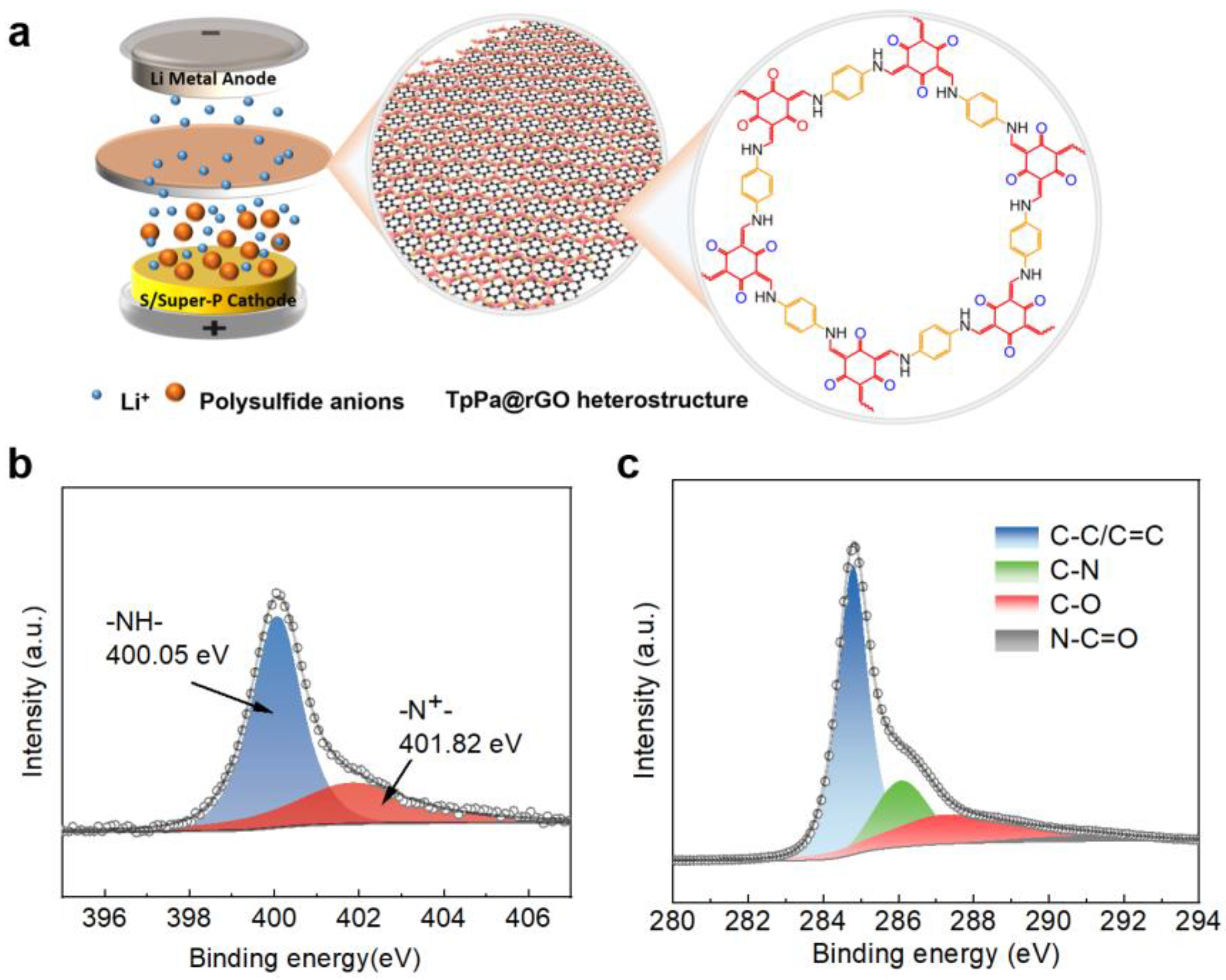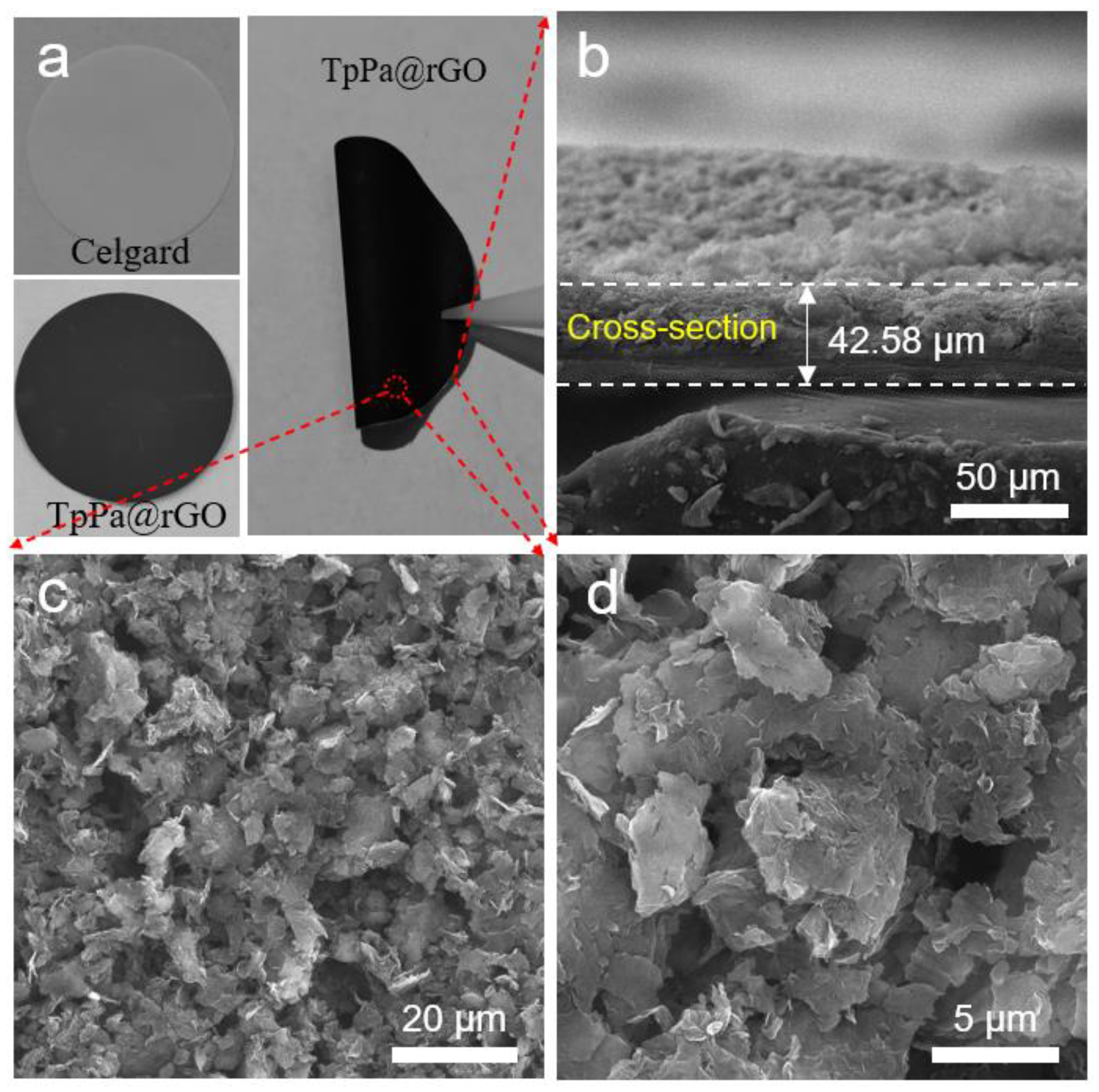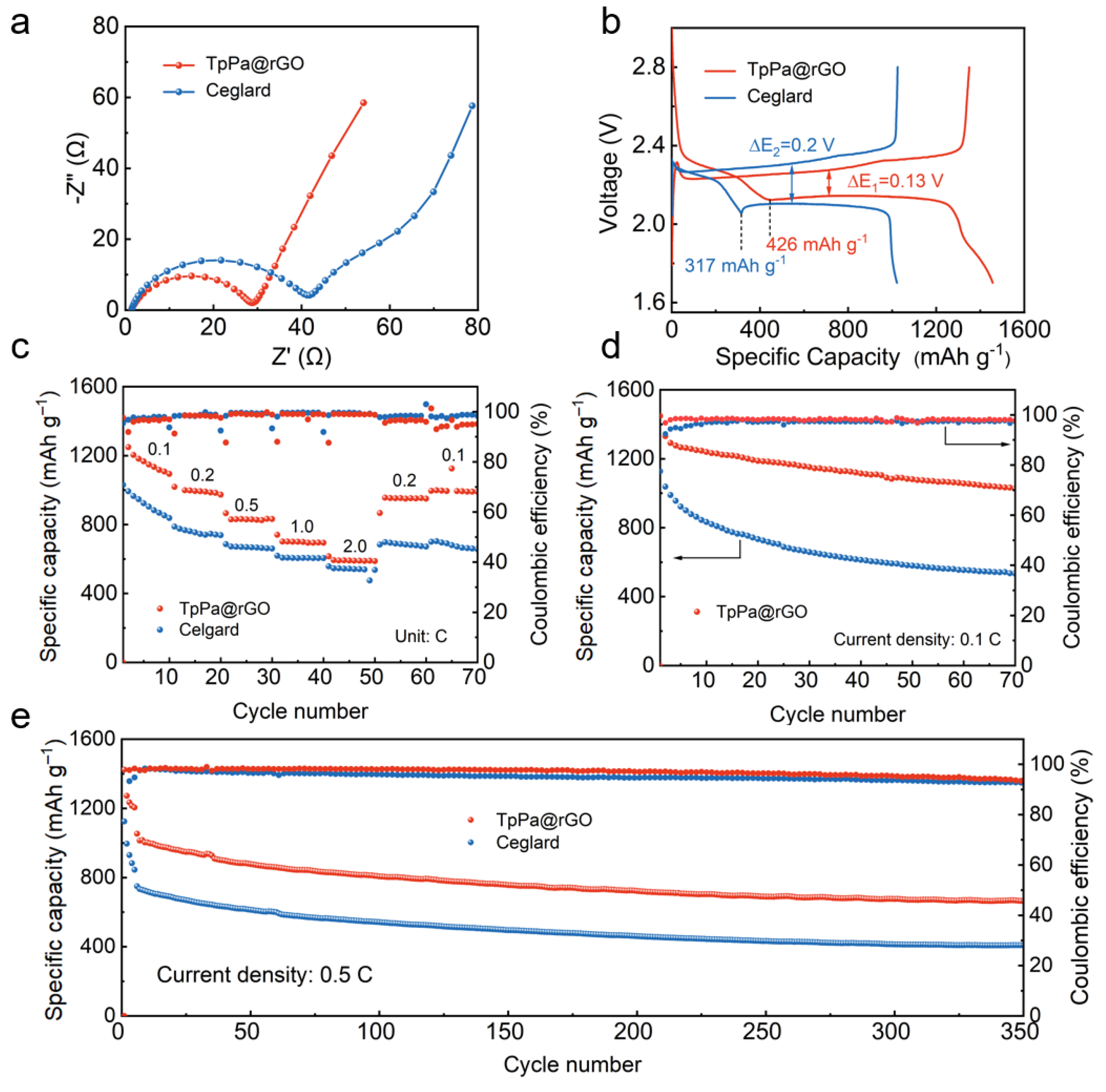A Two-Dimensional Heterostructured Covalent Organic Framework/Graphene Composite for Stabilizing Lithium–Sulfur Batteries
Abstract
:1. Introduction
2. Experimental Section
2.1. Material Synthesis
2.2. Electrochemical Performance Measurements
3. Results and Discussion
4. Conclusions
Supplementary Materials
Author Contributions
Funding
Data Availability Statement
Acknowledgments
Conflicts of Interest
References
- Seh, Z.W.; Sun, Y.; Zhang, Q.; Cui, Y. Designing high-energy lithium-sulfur batteries. Chem. Soc. Rev. 2016, 45, 5605–5634. [Google Scholar] [CrossRef] [PubMed]
- Wild, M.; O’Neill, L.; Zhang, T.; Purkayastha, R.; Minton, G.; Marinescu, M.; Offer, G.J. Lithium sulfur batteries, a mechanistic review. Energy Environ. Sci. 2015, 8, 3477–3494. [Google Scholar] [CrossRef]
- Yin, Y.-X.; Xin, S.; Guo, Y.-G.; Wan, L.-J. Lithium-sulfur batteries electrochemistry, materials, and prospects. Angew. Chem. Int. Ed. 2013, 52, 13186–13200. [Google Scholar] [CrossRef] [PubMed]
- Li, Y.; Guo, S. Material design and structure optimization for rechargeable lithium-sulfur batteries. Matter 2021, 4, 1142–1188. [Google Scholar] [CrossRef]
- Guo, R.; Yang, Y.; Huang, X.L.; Zhao, C.; Hu, B.; Huo, F.; Liu, H.K.; Sun, B.; Sun, Z.; Dou, S.X. Recent·advances·in multifunctional·binders·for high loading lithium-sulfur batteries. Adv. Funct. Mater. 2024, 34, 2307108. [Google Scholar] [CrossRef]
- Su, Y.-S.; Manthiram, A. Lithium-sulphur batteries with a microporous carbon paper as a bifunctional interlayer. Nat. Commun. 2012, 3, 1166. [Google Scholar] [CrossRef]
- Fan, L.; Li, M.; Li, X.; Xiao, W.; Chen, Z.; Lu, J. Interlayer material selection for lithium-sulfur batteries. Joule 2019, 3, 361–386. [Google Scholar] [CrossRef]
- Xia, P.; Li, S.; Yuan, L.; Jing, S.; Peng, X.; Lu, S.; Zhang, Y.; Fan, H.J. Encapsulating CoRu alloy nanocrystals intonitrogen-doped carbon nanotubes to synergistically modify lithium-sulfur batteries separator. Membr. Sci. 2024, 694, 122395. [Google Scholar] [CrossRef]
- Jeong, Y.C.; Kim, J.H.; Nam, S.; Park, C.R.; Yang, S.J. Rational design of nanostructured functionalInterlayer/separator for advanced Li-S batteries. Adv. Funct. Mater. 2018, 28, 1707411. [Google Scholar] [CrossRef]
- Huang, J.-Q.; Zhuang, T.-Z.; Zhang, Q.; Peng, H.-J.; Chen, C.-M.; Wei, F. Permselective graphene oxide membrane for highly stable and anti-sef-discharge lithium-sulfur batteries. ACS Nano 2015, 9, 3002–3011. [Google Scholar] [CrossRef]
- Huang, S.; Wang, Z.; Von Lim, Y.; Wang, Y.; Li, Y.; Zhang, D.; Yang, H.Y. Recent advances in heterostructure engineering for lithium sulfur batteries. Adv. Energy Mater. 2021, 11, 2003689. [Google Scholar] [CrossRef]
- Xiao, Z.; Yang, Z.; Wang, L.; Nie, H.; Zhong, M.E.; Lai, Q.; Xu, X.; Zhang, L.; Huang, S. A lightweight TiO2/graphene interlayer, applied as a highly effective polysulfide absorbent for fast, long-life lithium-sulfur batteries. Adv. Mater. 2015, 27, 2891–2898. [Google Scholar] [CrossRef]
- Kandambeth, S.; Dey, K.; Banerjee, R.J. Covalent organic frameworks: Chemistry beyond the structure. J. Am. Chem. Soc. 2019, 141, 1807–1822. [Google Scholar] [CrossRef]
- An, Q.; Wang, L.; Zhao, G.; Duan, L.; Sun, Y.; Liu, Q.; Mei, Z.; Yang, Y.; Zhang, C.; Guo, H. Constructing cooperative interface via Bi-functional COF for facilitating the sulfur conversion and Li+ dynamics. Adv. Mater. 2024, 36, 2305818. [Google Scholar] [CrossRef]
- Hu, B.; Xu, J.; Fan, Z.; Xu, C.; Han, S.; Zhang, J.; Ma, L.; Ding, B.; Zhuang, Z.; Kang, Q.; et al. Covalent Organic Framework Based Lithium-Sulfur Batteries: Materials, Interfaces, and solid-state electrolytes. Adv. Energy Mater. 2023, 13, 2203540. [Google Scholar] [CrossRef]
- Yoo, J.; Cho, S.-J.; Jung, G.Y.; Kim, S.H.; Choi, K.-H.; Kim, J.-H.; Lee, C.K.; Kwak, S.K.; Lee, S.-Y. COF-Net on CNT-Net as a molecularly designed, hierarchical porous chemical trap for polysulfides in lithium-sulfur batteries. Nano Lett. 2016, 16, 3292–3300. [Google Scholar] [CrossRef]
- Cao, Y.; Wu, H.; Li, G.; Liu, C.; Cao, L.; Zhang, Y.; Bao, W.; Wang, H.; Yao, Y.; Liu, S.; et al. Ion selective covalent organic framework enabling enhanced electrochemical performance of lithium-sulfur batteries. Nano Lett. 2021, 21, 2997–3006. [Google Scholar] [CrossRef]
- Wang, T.; He, J.; Zhu, Z.; Cheng, X.-B.; Zhu, J.; Lu, B.; Wu, Y. Heterostructures regulating lithium polysulfdes for advanced lithium-sulfur batteries. Adv. Mater. 2023, 35, 2303520. [Google Scholar] [CrossRef]
- Vincent, M.; Avvaru, V.S.; Rodríguez, M.C.; Haranczyk, M.; Etacheri, V. High-rate and ultralong-life Mg-Li hybridbatteries based on highly pseudocapacitive dual-phase TiO2 nanosheet cathodes. J. Power Sources 2021, 506, 230118. [Google Scholar] [CrossRef]
- Wu, S.; Jiang, Z.; Wu, C.; Li, H.; Huang, J.; Li, N.; Huang, S. High-content carbon layer confined small-molecule/covalent sulfur cathode enables long-life calcium-sulfur batteries in Hybrid-lon electrolyte. Adv. Funct. Mater. 2024, 2313441. [Google Scholar] [CrossRef]
- Pérez-Carvajal, J.; Boix, G.; Imaz, I.; Maspoch, D. The imine-Based COF TpPa-1 as an efficient cooling adsorbent that can be regenerated by heat or light. Adv. Energy Mater. 2019, 9, 1901535. [Google Scholar] [CrossRef]
- Ying, Y.; Tong, M.; Ning, S.; Ravi, S.K.; Peh, S.B.; Tan, S.C.; Pennycook, S.J.; Zhao, D. Ultrathin two-dimensional membranes assembled by ionic covalent organic nanosheets with reduced apertures for gas separation. J. Am. Chem. Soc. 2020, 142, 4472–4480. [Google Scholar] [CrossRef]
- Sun, J.; Klechikov, A.; Moise, C.; Prodana, M.; Enachescu, M.; Talyzin, A.V. A molecular pillar approach to grow vertical covalent organic framework nanosheets on graphene: Hybrid materials for energy storage. Angew. Chem. Int. Ed. 2018, 57, 1034–1038. [Google Scholar] [CrossRef]
- Li, Y.; Pei, B.; Chen, J.; Bing, S.; Hou, L.; Sun, Q.; Xu, G.; Yao, Z.; Zhang, L.J. Hollow nanosphere construction of covalent organic frameworks for catalysis:(Pd/C)@TpPa COFs in suzuki coupling reaction. Colloid. Interface Sci. 2021, 591, 273–280. [Google Scholar] [CrossRef]
- Karak, S.; Kumar, S.; Pachfule, P.; Banerjee, R. Porosity prediction through hydrogen bonding in covalent organic frameworks. J. Am. Chem. Soc. 2018, 140, 5138–5145. [Google Scholar] [CrossRef]
- Kandambeth, S.; Mallick, A.; Lukose, B.; Mane, M.V.; Heine, T.; Banerjee, R. Construction of crystalline 2D covalent organic frameworks with remarkable chemical (acid/base) stability via a combined reversible and irreversible route. J. Am. Chem. Soc. 2012, 134, 19524–19527. [Google Scholar] [CrossRef]
- Lei, R.; Zha, Z.; Hao, Z.; Wang, J.; Wang, Z.; Zhao, S. Ultrathin and high-performance covalent organic frameworks composite membranes generated by oligomer triggered interfacial polymerization. J. Membr. Sci. 2022, 650, 120431. [Google Scholar] [CrossRef]
- Zhang, H.; Li, X.; Xiao, C.; Xie, J.; Yan, X.; Wang, C.; Zhou, Y.; Qi, J.; Zhu, Z.; Sun, X.; et al. Enhanced selective electrosorption of Pb2+from complex water on covalent organic framework-reduced graphene oxide nanocomposite. Sep. Purif. Technol. 2022, 302, 122147. [Google Scholar] [CrossRef]
- Yao, Y.-H.; Li, J.; Zhang, H.; Tang, H.-L.; Fang, L.; Niu, G.-D.; Sun, X.-J.; Zhang, F.-M. Facile synthesis of a covalently connected rGO-COF hybrid material by in situ reaction for enhanced visible-light induced photocatalytic H2 evolution. J. Mater. Chem. A 2020, 8, 8949–8956. [Google Scholar] [CrossRef]
- Li, C.; Cao, S.; Lutzki, J.; Yang, J.; Konegger, T.; Kleitz, F.; Thomas, A. A covalent organic framework/graphene dual-region hydrogel for enhanced solar-driven water generation. J. Am. Chem. Soc. 2022, 144, 3083–3090. [Google Scholar] [CrossRef]
- Zhang, Y.; Guo, C.; Zhou, J.; Yao, X.; Li, J.; Zhuang, H.; Chen, Y.; Chen, Y.; Li, S.L.; Lan, Y.Q. Anisotropically hybridized porous crystalline Li-S battery separators. Small 2023, 19, 2206616. [Google Scholar] [CrossRef]
- Li, M.; Wang, Y.; Sun, S.; Yang, Y.; Gu, G.; Zhang, Z. Rational design of an allyl-rich triazine based covalent organic framework host usedas efficient cathode materials for Li-S batteries. Chem. Eng. J. 2022, 429, 132254. [Google Scholar] [CrossRef]
- Xu, J.; Bi, S.; Tang, W.; Kang, Q.; Niu, D.; Hu, S.; Zhao, S.; Wang, L.; Xin, Z.; Zhang, X. Duplex trapping and charge transfer with polysulfides by a diketopyrrolopyrrole-based organic framework for high-performance lithium-sulfur batteries. J. Mater. Chem. A 2019, 7, 18100–18108. [Google Scholar] [CrossRef]
- Shao, Q.; Wu, Z.-S.; Chen, J. Two-dimensional materials for advanced Li-S batteries. Energy Storage Mater. 2019, 22, 284–310. [Google Scholar] [CrossRef]
- Xing, C.; Chen, H.; Qian, S.; Wu, Z.; Nizami, A.; Li, X.; Zhang, S.; Lai, C. Regulating liquid and solid-state electrolytes for solid phase conversion in Li-S batteries. Chem 2022, 8, 1201–1230. [Google Scholar] [CrossRef]
- Shi, Z.; Tian, Z.; Guo, D.; Wang, Y.; Bayhan, Z.; Alzahrani, A.S.; Alshareef, H.N. Kinetically favorable Li-S battery electrolytes. ACS Energy Lett. 2023, 8, 3054–3080. [Google Scholar] [CrossRef]
- Xu, J.; An, S.; Song, X.; Cao, Y.; Wang, N.; Qiu, X.; Zhang, Y.; Chen, J.; Duan, X.; Huang, J.; et al. Towards high performance Li-S batteries via sulfonate-rich COF-modified separator. Adv. Mater. 2021, 33, 2105178. [Google Scholar] [CrossRef]




Disclaimer/Publisher’s Note: The statements, opinions and data contained in all publications are solely those of the individual author(s) and contributor(s) and not of MDPI and/or the editor(s). MDPI and/or the editor(s) disclaim responsibility for any injury to people or property resulting from any ideas, methods, instructions or products referred to in the content. |
© 2024 by the authors. Licensee MDPI, Basel, Switzerland. This article is an open access article distributed under the terms and conditions of the Creative Commons Attribution (CC BY) license (https://creativecommons.org/licenses/by/4.0/).
Share and Cite
Mao, Z.; Xu, C.; Li, M.; Song, P.; Ding, B. A Two-Dimensional Heterostructured Covalent Organic Framework/Graphene Composite for Stabilizing Lithium–Sulfur Batteries. Energies 2024, 17, 1559. https://doi.org/10.3390/en17071559
Mao Z, Xu C, Li M, Song P, Ding B. A Two-Dimensional Heterostructured Covalent Organic Framework/Graphene Composite for Stabilizing Lithium–Sulfur Batteries. Energies. 2024; 17(7):1559. https://doi.org/10.3390/en17071559
Chicago/Turabian StyleMao, Zhihao, Chong Xu, Mengyuan Li, Peng Song, and Bing Ding. 2024. "A Two-Dimensional Heterostructured Covalent Organic Framework/Graphene Composite for Stabilizing Lithium–Sulfur Batteries" Energies 17, no. 7: 1559. https://doi.org/10.3390/en17071559



